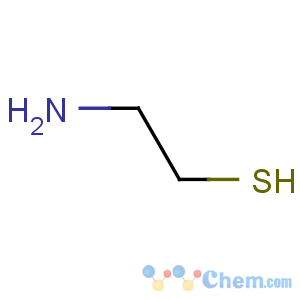Title: Cysteamine
CAS Registry Number: 60-23-1
CAS Name: 2-Aminoethanethiol
Synonyms: mercaptamine; b-mercaptoethylamine; 2-aminoethyl mercaptan; thioethanolamine; decarboxycysteine; MEA; mercamine
Manufacturers' Codes: L-1573
Trademarks: Becaptan (Labaz); Lambratene (formerly) (Cilag Italiano)
Molecular Formula: C2H7NS
Molecular Weight: 77.15
Percent Composition: C 31.14%, H 9.15%, N 18.16%, S 41.56%
Line Formula: HSCH2CH2NH2
Literature References: A sulfhydryl compound with a variety of biological effects. Prepn: Gabriel, Leupold,
Ber. 31, 2837 (1898); Knorr, R?ssler,
ibid. 36, 1281 (1903); Mills, Jr., Bogart,
J. Am. Chem. Soc. 62, 1173 (1940); Wenker,
ibid. 57, 2328 (1935); D. A. Shirley,
Preparation of Organic Intermediates (Wiley, New York, 1951) p 189. Use in treatment of paracetamol (acetaminophen) poisoning: L. F. Prescott
et al., Lancet 2, 109 (1976); A. L. Harris,
Br. Med. J. 284, 825 (1982). Effects in nephropathic cystinosis: M. Yudkoff
et al., N. Engl. J. Med. 304, 141 (1981). Radioprotective effects: R. P. Bird,
Radiat. Res. 72, 290 (1980); C. J. Koch, R. L. Howell,
ibid. 87, 265 (1981). Cysteamine has been shown to be a duodenal ulcerogen in rats: H. Selye, S. Szabo,
Nature 244, 458 (1973); S. Szabo,
Am. J. Pathol. 93, 273 (1978); P. Kirkegaard
et al., Scand. J. Gastroenterol. 15, 621 (1980).
Review: S. Szabo,
Lab. Invest. 51, 121 (1984). It has also been found to deplete somatostatin concentration: S. Szabo, S. Reichlein,
Endocrinology 109, 2255 (1981); S. M. Sagar
et al., J. Neurosci. 2, 225 (1982). In pituitary tissue, cysteamine is a potent depletor of prolactin concentrations
in vivo and
in vitro: W. J. Millard
et al., Science 217, 452 (1982). Toxicity studies: E. Beccari
et al., Arzneim.-Forsch. 5, 421 (1955); D. L. Klayman
et al., J. Med. Chem. 12, 510 (1969); P. K. Srivastava, L. Field,
ibid. 18, 798 (1975).
Properties: Crystals by sublimation
in vacuo. Disagreeable odor. mp 97-98.5°. Oxidizes to cystamine on standing in air. Freely sol in water, alkaline reaction. LD50 in mice (mg/kg): 625 orally; 250 i.p. (Klayman); (Srivastava, Field).
Melting point: mp 97-98.5°
Toxicity data: LD50 in mice (mg/kg): 625 orally; 250 i.p. (Klayman); (Srivastava, Field)
Derivative Type: Hydrochloride
Molecular Formula: C2H7NS.HCl
Molecular Weight: 113.61
Percent Composition: C 21.14%, H 7.10%, N 12.33%, S 28.22%, Cl 31.21%
Properties: Crystals from alc, mp 70.2-70.7°. Sol in water, alcohol. LD50 (cg/kg): 23.19 i.p. in rats; 14.95 i.v. in rabbits (Beccari).
Melting point: mp 70.2-70.7°
Toxicity data: LD50 (cg/kg): 23.19 i.p. in rats; 14.95 i.v. in rabbits (Beccari)
Use: Experimentally as a radioprotective agent and to produce acute and chronic duodenal ulcers in rats.
Therap-Cat: Antidote to acetaminophen.
Keywords: Antidote (Acetaminophen Poisoning).

